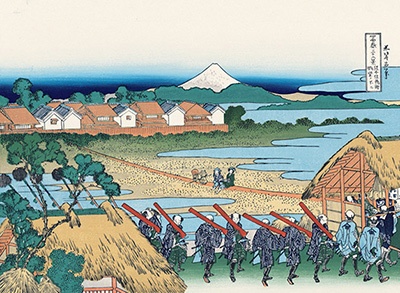Hokusai
Pleasure District at Senju by Hokusai
Katsushika Hokusai was a Japanese artist, renowned during the Edo period for his paintings, prints, and woodblocks. His block prints are especially famous. He studied wood block printing from Katsukawa Shunshō and published his first prints in 1779. His series, One Hundred Views of Mount Fuji, is generally considered a masterpiece.
Pleasure District at Senju is a depiction of the red-light area, more commonly known as the pleasure district in Japan. This district generally housed women who were prostitutes, but men could also frequent houses where women served as entertainers and servers, giving a boost to their egos. This picture is a woodblock print. It is one of a series of woodblock prints called Thirty Six Views of Mount Fuji. Despite its name, the series however has 46 blocks, since ten were added at a later date to the series. Pleasure District at Senju is among those added subsequently.
The picture depicts a scenery on the Senju Road. The daimyo is leading a procession, with a number of his samurais following, armed with their guns wrapped in reddish-brown cloth. All the samurais are dressed similarly in green tunics and blue robes. Each one carries two knives, as required by the samurai code of conduct. At the front of the procession, the daimyo is being carried on a litter by two attendants, dressed in grey.
Two women are sitting in the middle of the farm, watching the procession. The Senju pleasure district is in the background, depicted by a settlement of houses beyond the walls of the farm. Far in the distance, Mount Fuji dominates the skyline. The prevalence of the mountain in Hokusai’s works has a religious significance since Mount Fuji is a representation of immortal and eternal life in Japanese Buddhism. Hokusai was a Buddhist of the Nichiren sect and hence gave special attention to the sacred mountain in his various art works.
The Senju pleasure quarter was privately owned and was in operation until 1875.Pleasure District at Senju was originally created in 1830. There have been exhibitions of this block print, along with the other forty five. Currently, it is in the collection of Edo-Tokyo Museum in Japan.
